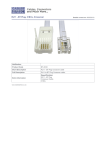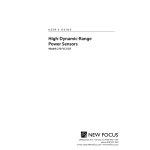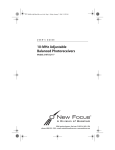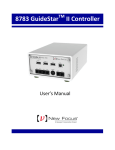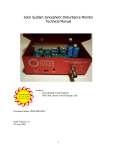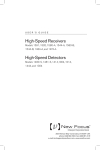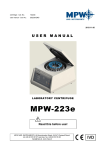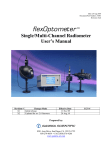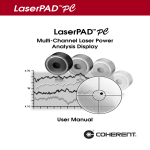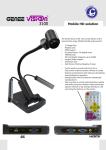Download Large-Area Photoreceivers
Transcript
203x LA Rcvr revC.fm Page 1 Friday, August 10, 2001 3:12 PM USER’S GUIDE Large-Area Photoreceivers Models 2031, 2032, 2033, & 2034 5215 Hellyer Ave. • San Jose, CA 95138-1001 • USA phone: (408) 284–6808 • fax: (408) 284–4824 e-mail: [email protected] • www.newfocus.com 203x LA Rcvr revC.fm Page 2 Friday, August 10, 2001 3:12 PM Warranty New Focus, Inc. guarantees its products to be free of defects for one year from the date of shipment. This is in lieu of all other guarantees, expressed or implied, and does not cover incidental or consequential loss. Information in this document is subject to change without notice. Copyright 2001, 1999, New Focus, Inc. All rights reserved. The New Focus, Inc. symbol and NEW FOCUS, Inc. are registered trademarks of Document Number 203107 Rev. C 203x LA Rcvr revC.fm Page 3 Friday, August 10, 2001 3:12 PM Contents Operation 5 Introduction . . . . . . . . . . . . . . . . . . . . . . . . . . . . . . . . . . . . . . . . . . . 5 Using the Photoreceiver . . . . . . . . . . . . . . . . . . . . . . . . . . . . . . . . . 7 Checking the Battery . . . . . . . . . . . . . . . . . . . . . . . . . . . . . . . . . . . . 8 General Features & Principles 11 Photoreceiver Circuitry . . . . . . . . . . . . . . . . . . . . . . . . . . . . . . . . 11 Optical Power and Output Voltage . . . . . . . . . . . . . . . . . . . . . 11 Frequency Response and Noise 13 Measuring Bandwidth. . . . . . . . . . . . . . . . . . . . . . . . . . . . . . . . . . 13 Measuring Noise. . . . . . . . . . . . . . . . . . . . . . . . . . . . . . . . . . . . . . . 13 Typical Frequency Response and Noise Spectra . . . . . . . . . 15 Using Filters and Optical Fiber 21 Characteristics 23 Physical Specifications . . . . . . . . . . . . . . . . . . . . . . . . . . . . . . . . . 23 Model 2031 Specifications . . . . . . . . . . . . . . . . . . . . . . . . . . . . . 24 Model 2032 Specifications . . . . . . . . . . . . . . . . . . . . . . . . . . . . . 25 Model 2033 Specifications . . . . . . . . . . . . . . . . . . . . . . . . . . . . . 26 Model 2034 Specifications . . . . . . . . . . . . . . . . . . . . . . . . . . . . . 27 Customer Service 28 Technical Support . . . . . . . . . . . . . . . . . . . . . . . . . . . . . . . . . . . . . 28 Service . . . . . . . . . . . . . . . . . . . . . . . . . . . . . . . . . . . . . . . . . . . . . . . . 28 Large-Area Photoreceivers Contents • 3 203x LA Rcvr revC.fm Page 4 Friday, August 10, 2001 3:12 PM 4 • Contents NEW FOCUS, Inc. 203x LA Rcvr revC.fm Page 5 Friday, August 10, 2001 3:12 PM Operation Introduction The Model 203X is a general-purpose, batterypowered photoreceiver with a large-area photodetector. There are four versions of the Model 203X receiver, each based on a different photodetector: Note: Model Wavelength Type Diam. 2031 400–1070 nm silicon 2032 190–1100 nm UV-enhanced silicon 2033 800–1750 nm germanium 5 mm 2034 800–2200 nm extended-λ InGaAs 1 mm 8 mm 5.8 mm Complete specifications for the Model 203X large-area photoreceivers begin on page 23. The large area of the photodetector makes it easy to couple light from a variety of sources (including diode lasers, broadband sources, and light from optical fibers) onto the detector without requiring precise optical alignment or focusing. Figures 1 and 2 on the following page show the typical responsivity curves for the different detectors. Large-Area Photoreceivers Operation • 5 203x LA Rcvr revC.fm Page 6 Friday, August 10, 2001 3:12 PM 1.0 Model 2033 Responsivity, A/W Figure 1: Typical responsivities of the Model 2031 & 2033 photodiodes 0.8 0.6 Model 2031 0.4 0.2 0.0 200 400 600 800 1000 1200 1400 1600 1800 2000 Wavelength, nm 1.2 Model 2034 1.0 Responsivity, A/W Figure 2: Typical responsivities of the Model 2032 & 2034 photodiodes 0.8 0.6 Model 2032 0.4 0.2 0.0 200 400 600 800 1000 1200 1400 1600 1800 2000 2200 Wavelength, nm Note: For more information on frequency response and noise, see page 13. The photoreceiver’s slim casing, shown on the next page, makes it easy to position it in a set-up between closely spaced optics. The switches and BNC output connector are located on top of the receiver for easy access. 6 • Operation NEW FOCUS, Inc. 203x LA Rcvr revC.fm Page 7 Friday, August 10, 2001 3:12 PM Figure 3: The Model 203X casing power switch battery-check LED gain setting output (BNC) photodetector 8-32 (M4) mounting threads Note: A full mechanical diagram of the Model 203X casing is available on page 23. Using the Photoreceiver 1. Check the battery voltage. The Model 203X is powered by a single 9-volt alkaline battery. To check the battery condition, push the red power switch to the BATT CHK position. If the green LED lights up, the battery is in good condition; if the LED does not light, the battery needs to be replaced (see page 8). 2. Mount the photoreceiver. Use the 8-32 thread (M4 for metric versions) on the bottom of the casing to mount the photoreceiver to a post or pedestal. The threading is seated in a non-conductive plastic pad to reduce the electrical noise associated with ground loops. Be careful not to over-tighten when attaching the casing to a post or pedestal, or the threaded insert can strip out of the plastic pad. 3. Connect the receiver output. Connect your voltmeter, oscilloscope, or other instrument to the Output BNC connector on top of the receiver. Large-Area Photoreceivers Operation • 7 203x LA Rcvr revC.fm Page 8 Friday, August 10, 2001 3:12 PM 4. Turn the power switch to “on.” The output voltage should register on your scope or instrument. 5. Align an optical beam onto the detector. Be careful to keep the optical power under the maximum optical power of 10 mW to avoid damaging the photodetector. 6. Adjust the gain. Use the black switch on top of the receiver to set the gain to low, medium, or high. The bandwidths vary with the gain setting (the label on the front of the photoreceiver indicates the gain and bandwidth values). 7. Turn the receiver off. When you are finished with the receiver, return the power switch to the “off” position. Checking the Battery The Model 203X is powered by a single, standard 9volt alkaline battery. Under normal operating conditions with low light levels and a high impedance load attached to the BNC connector, the photoreceiver draws about 1 mA from the battery, and the battery lifetime is approximately 500 hours. To check the condition of the battery, push the red power switch to the BATT CHK position. If the green LED lights up, the battery is in good condition. When the battery voltage falls below about 6.5 volts, the green LED will not light up, and the battery should be replaced. Replacing the Battery 1. Turn the red power switch to “off” to prevent damage to the receiver. 2. Remove the screw on the back of the photoreceiver casing and remove the back cover. 8 • Operation NEW FOCUS, Inc. 203x LA Rcvr revC.fm Page 9 Friday, August 10, 2001 3:12 PM 3. Unplug the old battery by rotating it away from the circuit board about the snap-on terminal contacts 4. Install a new 9-volt alkaline battery. 5. Reinstall the back cover and screw. 6. Test the new battery’s status by pushing the power switch to the BATT CHK position. Large-Area Photoreceivers Operation • 9 203x LA Rcvr revC.fm Page 10 Friday, August 10, 2001 3:12 PM 10 • Operation NEW FOCUS, Inc. 203x LA Rcvr revC.fm Page 11 Friday, August 10, 2001 3:12 PM General Features & Principles Photoreceiver Circuitry The circuitry inside the Model 203X consists of a photodiode followed by an electronic gain stage. The black switch on top of the casing allows you to select one of three gain settings: low (2x103 V/A), medium (105 V/A), and high (2x106 V/A). The label on the front of the casing lists the gain and bandwidth values for each of these three gain settings. The amplifier design is optimized so it consumes a minimum of power and generates a minimum of noise at each of the gain settings. A simplified schematic of the Model 203X circuitry is shown in Figure 4. Figure 4: Functional schematic of the Model 203X circuitry +V ON OFF LED Batt Chk Battery check circuit High Med. Amp. Output Low Optical Power and Output Voltage The typical operating range for these receivers is from a few nanowatts up to 2 to 5 mW (depending the model and gain setting). Be careful to keep the optical Large-Area Photoreceivers General Features & Principles • 11 203x LA Rcvr revC.fm Page 12 Friday, August 10, 2001 3:12 PM power under the maximum optical power of 10 mW to avoid damaging the photodetector. To compute the approximate output voltage for a given input optical power use the relationship Vout = Pin·R·G, where Pin is the input optical power in watts, R is the photodetector’s responsivity in A/W (see page 6 for typical responsivities), and G is the amplifier’s transimpedance gain in V/A. For example, the Model 2031 on the medium gain setting and with 10 µW of optical power at 900 nm will have an output voltage of approximately (10 µW)·(0.6 A/W)·(105 V/A) = 0.6 V. The maximum optical power that can be detected by the photoreceiver is determined by the input optical power at which the transimpedance gain stage saturates. We can calculate the saturation power at 900 nm for the Model 2031 assuming a maximum output voltage of 5 volts. (The output can typically generate greater than 5 volts, depending on the age of the battery, but to be conservative we assume a maximum output of 5 volts.) Using the expression 5 V = Psat·R·G, the Model 2031 has a saturation power of 4 mW for the low gain setting, 83 µW for the medium gain setting, and 4 µW for the high gain setting. At other wavelengths where the responsivity is lower, the saturation power increases inversely with responsivity. 12 • General Features & Principles NEW FOCUS, Inc. 203x LA Rcvr revC.fm Page 13 Friday, August 10, 2001 3:12 PM Frequency Response and Noise Measuring Bandwidth The frequency response and noise characteristics of the large-area photoreceiver depend on the selected gain. Figures 5–8 on the following pages give the typical frequency response and noise behavior for the photoreceivers at each of the three gain settings—low, medium, and high. The frequency response of the transimpedance gain is plotted using the expression 20·log[Gain(ƒ)/Gain(0)], where ƒ is the frequency and Gain(0) is the gain at DC. The photoreceiver’s bandwidth is defined as the frequency where the gain has decreased by 3 dB, or a factor of 2 . Measuring Noise The photoreceiver noise is characterized using the noise equivalent power (NEP), which is a measure of the weakest optical signal that the photoreceiver can detect. The NEP is the optical power which will produce a signal-to-noise ratio of 1 in a 1-Hz bandwidth. The minimum detectable optical power can be found using the relationship Minimum Optical Power = NEP · BW , where BW is the bandwidth. Note that NEP is a wavelength-dependent quantity that changes with the photodetector’s responsivity. Large-Area Photoreceivers Frequency Response and Noise • 13 203x LA Rcvr revC.fm Page 14 Friday, August 10, 2001 3:12 PM Another way to characterize the noise is with the photocurrent noise (In), which is related to NEP by In = R · NEP, where R is the photodetector’s responsivity. The photocurrent noise is independent of wavelength because it gives the photoreceiver’s noise with the photodetector’s responsivity factored out. To characterize the noise of the large-area photoreceiver, the output electrical noise spectrum is measured with a spectrum analyzer. This voltage noise spectrum is converted to an equivalent optical photocurrent noise by dividing the voltage noise by the transimpedance gain (V/A). The photocurrent noise, In(ƒ), has units of pA/ Hz and is plotted in Figures 5–8 using the expression 20·log[In(ƒ)/1 A]. Calculating NEP The noise equivalent power (NEP) can be calculated by dividing the photocurrent noise by R, the detector’s responsivity (see figures 1 and 2 on page 6). For instance, the Model 2031 on the high gain setting has a minimum photocurrent noise of 0.9 pA/ Hz (see Figure 5c). When operating around 900 nm where the responsivity is about 0.6 A/W, the NEP is 1.5 pW/ Hz . From 10 kHz to 90 kHz the photocurrent noise rises by about 10 dB to a peak noise of 2.8 pA/ Hz , corresponding to a peak NEP of 4.7 pW/ Hz . From DC to 90 kHz the average photocurrent noise for the Model 2031 on the high gain setting is about 2 pA/ Hz , corresponding to an average NEP at 900 nm of 3.3 pW/ Hz . The integrated noise equivalent power from DC to 90 kHz is then obtained by multiplying the average NEP by BW , the square root of the bandwidth. The expression BW = 2πƒ3-dB/4 for a one-pole lowpass filter is useful for calculating the equivalent noise bandwidth. For the Model 2031 with a 3-dB bandwidth of 90 kHz, the equivalent noise bandwidth is 140 kHz. 14 • Frequency Response and Noise NEW FOCUS, Inc. 203x LA Rcvr revC.fm Page 15 Friday, August 10, 2001 3:12 PM This gives an optical noise equivalent power of about 1.2 nW, so the minimum detectable optical signal at 900 nm (with a signal-to-noise ratio of 1) for the Model 2031 on the high gain setting is 1.2 nW. Calculating Output-Voltage Noise The output-voltage noise can be calculated from G · R · NEP · BW , where G is the transimpedance gain (V/A), R is the photodiode responsivity (A/W), NEP is the average noise equivalent power, and BW is the bandwidth. This gives an output noise voltage for the Model 2031 on the high gain setting of (2x106 V/A) · (0.6 A/W) · (3.3 pW/ Hz ) · 140kHz =1.5 mVrms. Summary To summarize, for the Model 2031 on the high gain setting the average NEP is 3.3 pW/ Hz, and this yields an output noise voltage of 1.5 mVrms. Viewed another way, for operation at the peak responsivity wavelength of 900 nm and for the High gain setting, you will achieve a signal-to-noise ratio of unity if the input power is 1.2 nW. Note that this assumes operation without any post-photoreceiver filtering and with the full photoreceiver bandwidth of 90 kHz. By using an electronic band-pass filter or an optical chopper and a lock-in amplifier, the receiver can detect significantly weaker optical signals. Typical Frequency Response and Noise Spectra The 3-dB frequency bandwidth is defined as the frequency where the photoreceiver’s transimpedance gain has decreased by a factor of 2 . For the Model 2031 on the low setting the gain is 2x103 V/A and the bandwidth is 1 MHz. The gain on the medium setting is 105 V/A, and the bandwidth is 150 kHz. The gain on Large-Area Photoreceivers Frequency Response and Noise • 15 203x LA Rcvr revC.fm Page 16 Friday, August 10, 2001 3:12 PM the high setting is 2x106 V/A, and the bandwidth is 90 kHz. The noise spectrum is plotted in units of photocurrent noise, pA/ Hz . a. Frequency Response 10 dB/div Figure 5: Typical frequency response and noise spectra for the Model 2031 large-area visible photoreceiver with the gain set to (a) Low, (b) Medium, and (c) High Noise 26 pA/√Hz 10 2 3 4 10 5 10 10 10 6 Frequency, Hz b. 10 dB/div Frequency Response Noise 0.8 pA/√Hz 10 2 10 3 4 5 10 10 Frequency, Hz c. 10 dB/div Frequency Response Noise 0.9 pA/√Hz 10 2 10 3 4 10 10 5 Frequency, Hz 16 • Frequency Response and Noise NEW FOCUS, Inc. 203x LA Rcvr revC.fm Page 17 Friday, August 10, 2001 3:12 PM For the Model 2032 the bandwidth is 900 kHz for the low gain setting and 150 kHz for the medium and high gain settings. a. 10 dB/div Frequency Response Noise 29 pA/√Hz 10 2 10 3 10 4 10 5 10 6 Frequency, Hz b. Frequency Response 10 dB/div Figure 6: Typical frequency response and noise spectra for the Model 2032 UV-enhanced photoreceiver with the gain set to (a) Low, (b) Medium, and (c) High Noise 1.2 pA/√Hz 10 2 10 3 10 4 10 5 Frequency, Hz c. 10 dB/div Frequency Response Noise 1.1 pA/√Hz 10 2 10 3 10 4 10 5 Frequency, Hz Large-Area Photoreceivers Frequency Response and Noise • 17 203x LA Rcvr revC.fm Page 18 Friday, August 10, 2001 3:12 PM For the Model 2033 the bandwidth is 200 kHz for the low gain setting, 30 kHz for the medium gain setting, and 30 kHz for the high gain setting. a. Frequency Response 10 dB/div Figure 7: Typical frequency response and noise spectra for the Model 2033 large-area IR photoreceiver with the gain set to (a) Low, (b) Medium, and (c) High Noise 35 pA/√Hz 10 2 3 4 10 10 10 Frequency, Hz 5 b. 10 dB/div Frequency Response Noise 14 pA/√Hz 10 2 3 10 Frequency, Hz 10 4 10 5 c. 10 dB/div Frequency Response Noise 12 pA/√Hz 10 2 18 • Frequency Response and Noise 3 10 Frequency, Hz 10 4 10 5 NEW FOCUS, Inc. 203x LA Rcvr revC.fm Page 19 Friday, August 10, 2001 3:12 PM For the Model 2034 the bandwidth is 700 kHz for the low gain setting, 90 kHz for the medium gain setting, and 80 kHz for the high gain setting. a. 10 dB/div Frequency Response Noise 39 pA/√Hz 10 2 b. 10 3 10 4 10 Frequency, Hz 5 10 6 Frequency Response 10 dB/div Figure 8: Typical frequency response and noise spectra for the Model 2034 extendedwavelength InGaAs photoreceiver with the gain set to (a) Low, (b) Medium, and (c) High Noise 2.2 pA/√Hz 10 2 10 3 10 4 10 5 Frequency, Hz c. 10 dB/div Frequency Response Noise 2.2 pA/√Hz 10 2 10 3 10 4 10 5 Frequency, Hz Large-Area Photoreceivers Frequency Response and Noise • 19 203x LA Rcvr revC.fm Page 20 Friday, August 10, 2001 3:12 PM 20 • Frequency Response and Noise NEW FOCUS, Inc. 203x LA Rcvr revC.fm Page 21 Friday, August 10, 2001 3:12 PM Using Filters and Optical Fiber New Focus offers accessories to attach a 1"-diameter filter or an optical fiber to the Model 203X large-area photoreceiver. These accessories are sold separately, and they are not supplied with the photoreceiver. Both accessories attach to the photoreceiver using the 1.0432 threads located in the casing around the photodetector. Note that the accessories are also compatible with two other New Focus products, the Model 215X femtowatt photoreceiver and the Model 162X nanosecond photodetector. The Model 1280 1" filter holder allows you to mount a 1"-diameter optic in front of the photodetector. For instance, you can mount a colored glass filter to remove unwanted wavelengths or mount a neutraldensity filter to attenuate the optical power incident on the photodetector. The Model 1280 has a plastic ring for mounting a filter that is up to about 0.25" (6.4-mm) thick. A thicker optic can be held in place using the 6-32 nylon-tipped set screw. Use a 1/16" or 1.5-mm Allen key or ball-driver to adjust the set screw. The Model 1281 FC fiber adapter allows you to connect an FC-connectorized fiber to the front of the photodetector. See Figure 9 on the next page for drawings of these two accessories. Large-Area Photoreceivers Using Filters and Optical Fiber • 21 203x LA Rcvr revC.fm Page 22 Friday, August 10, 2001 3:12 PM Figure 9: Model 1280 filter holder and Model 1281 FC-fiber adapter holes for tightening 1.04-32 thread Retaining ring for holding 1" or 25-mm optics. 0.1 (3.23" ) 0.6 (15 3" .9) 6-32 nylon-tipped setscrew for holding 1" or 25-mm optics. dia. 1.30" (33.0) Model 1280 patent pending 1.04-32 thread holes for tightening 0.3 (8.95" ) 0.1 (4.89" ) FC connector Model 1281 22 • Using Filters and Optical Fiber NEW FOCUS, Inc. 203x LA Rcvr revC.fm Page 23 Friday, August 10, 2001 3:12 PM Characteristics Physical Specifications Figure 10: Mechanical drawing of the Model 203X casing 2.50 (63.5) 1.16 (29.5) Battery check LED Output (BNC) Gain setting switch Power switch 1.040-32 Threaded hole 4.03 (102.4) 1.00 (25.4) 1.25 (31.8) 8-32 (M4) Threaded insert Large-Area Photoreceivers Characteristics • 23 203x LA Rcvr revC.fm Page 24 Friday, August 10, 2001 3:12 PM Model 2031 Specifications Model 2031 Wavelength Range 400-1070 nm Detector Material/Type Silicon/PIN Detector Diameter 8 mm Typical Max. Responsivity 0.6 A/W (at 900 nm) Maximum Power Density 10 mW/mm2 Maximum Optical Power 10 mW Gain Settings Low Med. High Transimpedance Gain (V/A) 2x103 105 2x106 3-dB Bandwidth 1 MHz 150 kHz 90 kHz Max. Conversion Gain (V/W) 1.2x103 0.6x105 1.2x106 cw Saturation Pwr (at 900 nm) 4 mW 83 µW 4 µW 43 1.3 1.5 Typical Min. NEP (pW/ Hz ) Output Impedance 100 Ω Electrical Output Connector BNC Power Requirements One 9-volt alkaline battery Battery Lifetime (approx.) 500 hours 24 • Characteristics NEW FOCUS, Inc. 203x LA Rcvr revC.fm Page 25 Friday, August 10, 2001 3:12 PM Model 2032 Specifications Model 2032 Wavelength Range 190–1100 nm Detector Material/Type UV-enhanced silicon/PIN Detector Diameter 5.8 mm Typical Max. Responsivity 0.5 A/W (at 960 nm) Maximum Power Density 10 mW/mm2 Maximum Optical Power 10 mW Gain Settings Low Med. High Transimpedance Gain (V/A) 2x103 105 2x106 900 kHz 150 kHz 150 kHz Max. Conversion Gain (V/W) 1x103 0.5x105 1x106 cw Saturation Pwr (at 960 nm) 5 mW 100 µW 5 µW 3-dB Bandwidth Typical Min. NEP (pW/ Hz ) 58 2.4 2.2 Output Impedance 100 Ω Electrical Output Connector BNC Power Requirements One 9-volt alkaline battery Battery Lifetime (approx.) 500 hours Large-Area Photoreceivers Characteristics • 25 203x LA Rcvr revC.fm Page 26 Friday, August 10, 2001 3:12 PM Model 2033 Specifications Model 2033 Wavelength Range 800–1750 nm Detector Material/Type Ge/PN Detector Diameter 5 mm Typical Max. Responsivity 0.8 A/W (at 1500 nm) Maximum Power Density 6 mW/mm2 Maximum Optical Power 10 mW Gain Settings Low Med. High Transimpedance Gain (V/A) 2x103 105 2x106 3-dB Bandwidth 200 kHz 30 kHz 30 kHz Max. Conversion Gain (V/W) 1.6x103 0.8x105 1.6x106 cw Saturation Pwr (at 1500 nm) 3 mW 63 µW 3 µW 44 18 15 Typical Min. NEP (pW/ Hz ) Output Impedance 100 Ω Electrical Output Connector BNC Power Requirements One 9-volt alkaline battery Battery Lifetime (approx.) 500 hours 26 • Characteristics NEW FOCUS, Inc. 203x LA Rcvr revC.fm Page 27 Friday, August 10, 2001 3:12 PM Model 2034 Specifications Model 2034 Wavelength Range 800–2200 nm Detector Material/Type extended-wavelength InGaAs/ PIN Detector Diameter 1 mm Typical Max. Responsivity 1.1 A/W (at 1950 nm) Maximum Power Density 5 mW/mm2 Maximum Optical Power 5 mW Gain Settings Low Med. Transimpedance Gain (V/A) 2x103 105 2x106 3-dB Bandwidth 700 kHz 90 kHz 80 kHz Max. Conversion Gain (V/W) 2.2x103 1.1x105 2.2x106 cw Saturation Pwr (at 1950 nm) 2.3 mW 45 µW 2.3 µW Typical Min. NEP (pW/ Hz ) 35 2 High 2 Output Impedance 100 Ω Electrical Output Connector BNC Power Requirements One 9-volt alkaline battery Battery Lifetime (approx.) 500 hours Large-Area Photoreceivers Characteristics • 27 203x LA Rcvr revC.fm Page 28 Friday, August 10, 2001 3:12 PM Customer Service Technical Support Information and advice about the operation of any New Focus product is available from our applications engineers. For quickest response, ask for “Technical Support” and know the model and serial numbers for your product. Hours: 8:00–5:00 PST, Monday through Friday (excluding holidays). Toll Free: 1-866-NUFOCUS (1-866-683-6287) (from the USA & Canada only) Phone: (408) 284-6808 Support is also available by fax and email: Fax: (408) 980-8883 Email: [email protected] We typically respond to faxes and email within one business day. Service In the event that your photoreceiver malfunctions or becomes damaged, please contact New Focus for a return authorization number and instructions on shipping the unit back for evaluation and repair. 28 • Customer Service NEW FOCUS, Inc.





























